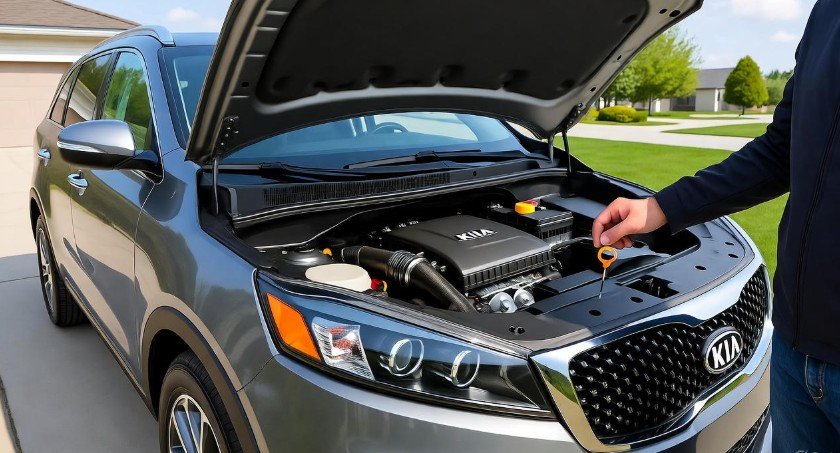How to Check Transmission Fluid on Kia Sorento: Step-by-Step Guide

Keeping your Kia Sorento running smoothly requires a bit more than just filling the gas tank and washing it every week. One often overlooked yet critical aspect of maintenance is checking the transmission fluid. This bright red lifeline flows through your vehicle’s transmission system, lubricating gears, maintaining hydraulic pressure, and helping your Sorento shift smoothly. Ignoring it can lead to costly repairs and a frustrating driving experience. Think of transmission fluid as the lifeblood of your car — if it’s low or contaminated, your engine may struggle, and the gears might resist instead of glide.
Many car owners underestimate how easy it is to check transmission fluid. It’s not rocket science, but skipping it is like ignoring the warning signs of a slowly leaking roof. In this guide, I’ll walk you through the step-by-step process of checking transmission fluid on your Kia Sorento, share insider tips, and explain why this simple check can save you thousands.
Why Checking Transmission Fluid Matters
Transmission fluid is more than just a colorful liquid under the hood. It’s a multi-tasker that keeps your Sorento operating at peak performance. Here’s why it’s so essential:
-
Lubricates internal components: Transmission gears and clutches experience intense friction. Fluid reduces wear and tear.
-
Cools the transmission: Just like a radiator cools your engine, transmission fluid keeps your transmission from overheating.
-
Ensures smooth shifting: Adequate fluid creates the hydraulic pressure necessary for flawless gear changes.
-
Prevents costly repairs: Low or dirty fluid is the silent culprit behind slipping gears, rough shifts, and eventual transmission failure.
Imagine driving on a smooth highway. Now imagine the car hesitating or jerking every time you shift — that’s what happens when transmission fluid is neglected. By checking it regularly, you can detect issues early and avoid expensive repairs. Many Sorento owners don’t realize that a simple monthly check can prevent headaches down the road.
Preparing to Check Your Transmission Fluid
Before diving under the hood, a little preparation goes a long way. Checking transmission fluid isn’t dangerous, but it does require some care:
-
Park on a level surface: This ensures an accurate reading.
-
Warm up your engine: Transmission fluid expands when warm, giving a precise level measurement.
-
Keep a clean cloth handy: You’ll need it to wipe the dipstick clean.
-
Use proper fluid: Check your owner’s manual for the recommended automatic transmission fluid type.
A quick tip: Avoid checking the fluid immediately after driving long distances if the engine is extremely hot. Wait a few minutes for it to settle — too much heat can give a false high reading. Think of it as letting a hot cup of coffee cool slightly before taking a sip; it’s all about accuracy and safety.
Step 1: Locate the Transmission Fluid Dipstick
Finding the dipstick is easier than most people think. In the Kia Sorento, it’s typically near the back of the engine bay, close to the firewall. Manufacturers often make it noticeable by coloring it bright yellow or red.
If you’ve never lifted the hood before, here’s a small trick: trace the path from your engine oil dipstick or look for a slightly smaller tube labeled “ATF” (Automatic Transmission Fluid).
Pro Tip: Take a picture of your dipstick with your phone for reference. It helps if you’re ever in a hurry or teaching someone else how to do this.
Step 2: Pull Out the Dipstick and Wipe Clean
Once you’ve located the dipstick:
-
Pull it out gently.
-
Use a clean cloth or paper towel to wipe it completely.
This step ensures that old fluid on the dipstick doesn’t give you a misleading reading. Picture this: if you dip your finger into a paint bucket and don’t wipe it first, the color you see won’t be accurate — it’s the same with transmission fluid.
Wiping the dipstick also lets you inspect the initial fluid residue. Healthy transmission fluid is clear, pinkish, and slightly sweet-smelling. If it’s dark brown or has a burnt odor, that’s an early warning sign that a fluid change is due.
Step 3: Reinsert the Dipstick and Pull It Out Again
After cleaning, fully reinsert the dipstick and pull it out again to check the fluid’s level and condition. Look closely at the markings on the dipstick, usually labeled “Hot” or “Warm”.
-
If the level is within the range, congratulations — your fluid is at a safe level.
-
If it’s below, your transmission is low on fluid, and you’ll need to top it up.
This step may seem simple, but accuracy is key. Too much fluid can be just as harmful as too little, creating foaming or even internal leaks. It’s like filling a glass to the brim: spill a little and it’s fine; overfill and you make a mess.
Step 4: Inspect the Fluid Condition
Checking fluid condition is just as important as checking the level. Here’s what to look for:
| Fluid Color | Condition | Action Required |
|---|---|---|
| Pink or Red | Healthy | No action needed |
| Brown | Old or burnt | Consider a fluid change |
| Dark brown or black | Contaminated | Immediate replacement |
| Milky or cloudy | Possibly water contamination | Inspect transmission |
Healthy fluid should glide smoothly on the dipstick and smell slightly sweet. If it smells burnt or thick, it indicates overheating or internal wear. Ignoring this can lead to slipping gears, erratic shifts, and expensive repairs.
Step 5: Add or Replace Fluid if Needed
If your Sorento’s transmission fluid is low, adding the recommended type is straightforward. Here’s how:
-
Open the transmission fluid cap (check the owner’s manual for exact location).
-
Use a funnel to avoid spills.
-
Pour slowly, checking the dipstick frequently.
If the fluid is old or contaminated, it’s time for a complete transmission fluid change. While topping up is simple, flushing old fluid often requires professional equipment to remove all debris and contaminants effectively. Think of it as cleaning a smoothie blender: wiping it out isn’t enough; sometimes, you need a full wash to avoid buildup.
When to Check Your Transmission Fluid
Knowing when to check transmission fluid is as important as knowing how. Here are some practical tips:
-
Monthly routine: Once a month keeps things safe and predictable.
-
Before long trips: Heavy loads and long drives put extra stress on your transmission.
-
After towing: Towing can accelerate fluid breakdown.
-
If you notice symptoms: Slipping gears, rough shifts, or overheating are red flags.
By making fluid checks a habit, you extend the life of your transmission and avoid surprise repair bills. Many owners wait too long, and what could’ve been a simple fluid top-up turns into a costly transmission rebuild.
Here’s a quick summary for beginners:
-
Dipstick location: Near the back of the engine bay.
-
Fluid color: Pink/red is healthy.
-
Fluid smell: Slightly sweet, not burnt.
-
Frequency: Check monthly or before heavy use.
Common Signs Your Kia Sorento May Have Low Transmission Fluid
Even if you haven’t checked your transmission fluid in a while, your Sorento may give you hints that something is off. Being aware of these symptoms can save you from major repairs:
-
Slipping gears: Your Sorento may unexpectedly shift out of gear or struggle to stay in the correct gear.
-
Delayed or rough shifting: Hesitation, jerks, or clunks when changing gears indicate fluid issues.
-
Overheating: Transmission fluid helps cool your system. If it’s low, the transmission can overheat, triggering dashboard warnings.
-
Burning smell: A burnt odor is a clear warning that the fluid is old or overheated.
-
Strange noises: Whining, humming, or grinding sounds often point to inadequate lubrication.
Think of these signs as your car “talking” to you. Ignoring them is like ignoring a toothache — the longer you wait, the worse it gets. Regular checks can catch these issues early and prevent expensive fixes.
Tips for Maintaining Your Kia Sorento’s Transmission
Checking the fluid is essential, but proper maintenance goes beyond a dipstick. Here are some expert tips to keep your transmission healthy:
-
Stick to the recommended fluid: Using the wrong type can cause damage. Always check the owner’s manual.
-
Schedule fluid changes: Even if levels are okay, old fluid loses effectiveness over time. Most manufacturers recommend changing it every 30,000–60,000 miles.
-
Avoid aggressive driving: Rapid acceleration, hard braking, and frequent towing increase transmission stress.
-
Keep the transmission cool: Don’t overload your Sorento, and ensure your cooling system is in top shape.
-
Watch for leaks: Transmission leaks often start small. Catching them early prevents major damage.
By combining these tips with regular checks, you’re not just maintaining a vehicle—you’re protecting a valuable investment and ensuring years of smooth drives.
Frequently Asked Questions About Checking Transmission Fluid on Kia Sorento
1. How Often Should I Check My Kia Sorento’s Transmission Fluid?
It’s wise to check the transmission fluid at least once a month. If your vehicle experiences heavy towing or frequent stop-and-go driving, checking more often is recommended. Regular checks help prevent minor issues from escalating.
2. Can I Check My Kia Sorento’s Transmission Fluid at Home?
Yes! With the step-by-step guide outlined above, you can easily check your transmission fluid at home. All you need is a clean cloth, the proper fluid, and a few minutes. It’s simple, cost-effective, and avoids unnecessary service visits.
3. What Type of Transmission Fluid Does a Kia Sorento Use?
The Kia Sorento typically requires manufacturer-recommended automatic transmission fluid. Using the wrong type can damage internal components. Always consult your owner’s manual or a certified mechanic for guidance.
4. What Are the Signs of Low Transmission Fluid?
Watch out for slipping gears, rough shifting, overheating, or a burning smell. Early detection allows you to top up fluid or replace it before major damage occurs.
5. What Should I Do If My Transmission Fluid Looks Dirty?
Dirty or burnt-smelling fluid is a red flag. Schedule a full transmission fluid change with a qualified mechanic. Avoid topping up alone, as this won’t remove contaminants that can cause internal wear.
6. Can I Overfill Transmission Fluid in My Kia Sorento?
Yes, overfilling can be just as harmful as low fluid. Too much fluid can foam, reduce lubrication efficiency, and even leak, causing damage. Always fill gradually and recheck the dipstick frequently.
7. Is Transmission Fluid Change Different for Automatic vs. Manual Kia Sorento?
Yes. Automatic transmissions rely heavily on hydraulic fluid to shift smoothly, while manual transmissions may use gear oil. Always check the specific type recommended for your Sorento model.
Troubleshooting Transmission Issues
Even with careful monitoring, issues can arise. Here’s a brief guide for troubleshooting common transmission problems:
-
Fluid leaks: Look under the car for red or brown puddles. Leaks often come from seals, gaskets, or fluid lines.
-
Delayed engagement: If your Sorento hesitates when shifting from park to drive, low or degraded fluid may be the culprit.
-
Jerky shifting: This could indicate old fluid, clogged filters, or worn components. Professional inspection is advised.
-
Warning lights: A transmission or check engine light often signals fluid issues or sensor problems. Don’t ignore these warnings.
These issues highlight why keeping transmission fluid levels and condition in check is crucial. Regular monitoring can catch problems before they turn into major repairs.
Simple Maintenance Routine for a Healthy Transmission
Here’s a quick maintenance checklist for your Kia Sorento:
-
Check transmission fluid monthly.
-
Inspect fluid condition for color and smell.
-
Top up only with manufacturer-recommended fluid.
-
Schedule fluid changes every 30,000–60,000 miles.
-
Avoid aggressive driving, heavy towing, and overloading.
-
Monitor for leaks or unusual noises.
Following this routine ensures your Sorento’s transmission stays smooth, reliable, and long-lasting. Think of it as giving your car a regular health check — small actions today prevent big problems tomorrow.
Conclusion
Checking the transmission fluid on your Kia Sorento is simple, quick, and essential. It’s a proactive step that protects your investment and ensures smooth, safe driving. By following the step-by-step guide, monitoring fluid levels and condition, and scheduling regular maintenance, you can prevent costly repairs and extend the life of your vehicle.
Remember, the transmission is the heart of your car’s performance. Treat it well, and it will reward you with years of reliable, effortless driving. If you notice unusual signs, such as slipping gears, rough shifting, or burnt-smelling fluid, consult a professional mechanic immediately. With routine checks and care, your Kia Sorento will continue to deliver the performance and comfort you expect, mile after mile.






